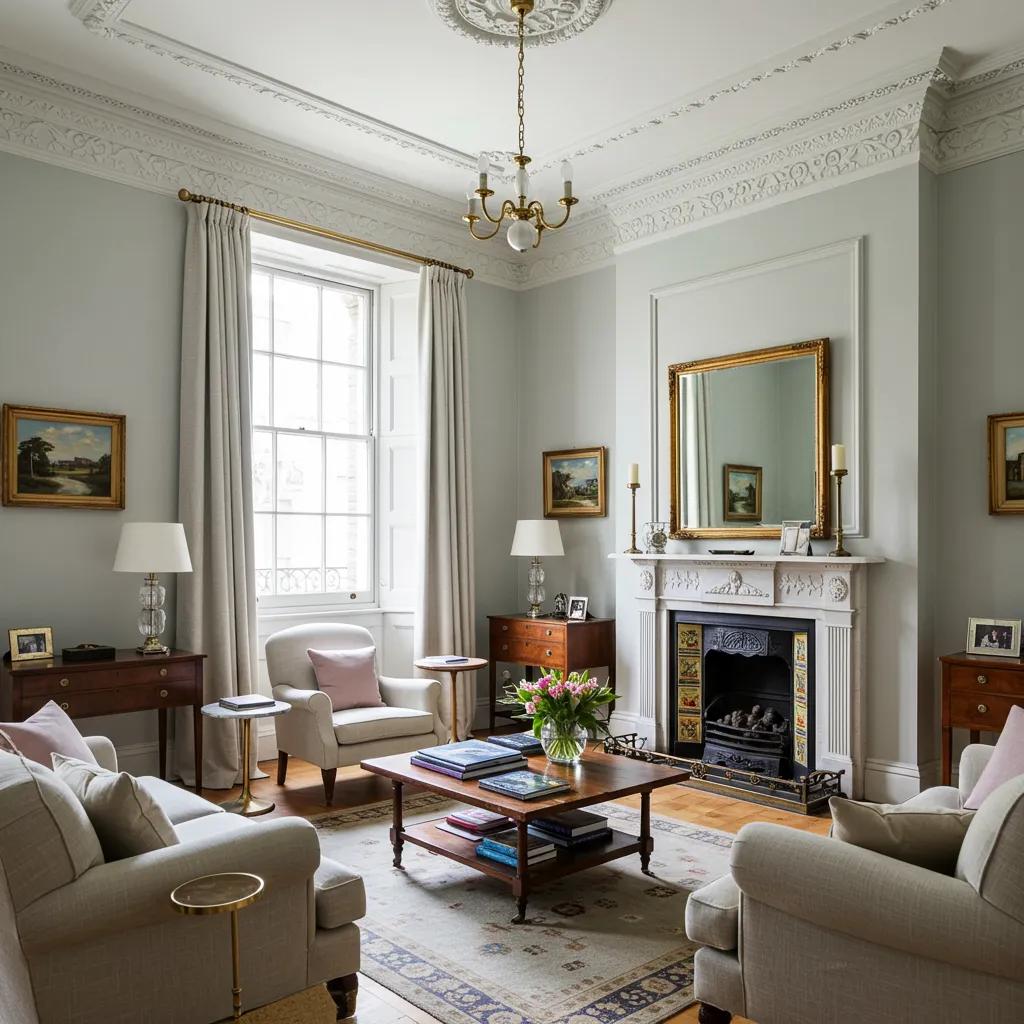
Discover Essential Secrets of Traditional Fulham Home Decor
Unlock the Secrets to Timeless Fulham Home Decor: Expert Styling for Period Properties

Creating a Fulham home that beautifully blends Victorian or Edwardian heritage with modern comfort is an art that requires a specialist touch. This guide unveils the essential secrets for styling period properties—from identifying distinctive architectural features and choosing authentic colour schemes to breathing new life into cornices, designing classic kitchens, and selecting a local decorator known for exceptional craftsmanship. Homeowners will discover how to enhance original sash windows, optimise heritage colour palettes, and achieve stunning results with cost-effective kitchen cabinet resprays. Throughout, you'll see how K Wyatt Decorators’ family-run commitment, City & Guilds accreditation, and a decade of dedicated experience in West London’s period properties underpin every restoration and styling choice.
What Defines Traditional Fulham Home Decor?
Traditional Fulham home decor masterfully combines the grandeur of Victorian design with the airy elegance of the Edwardian era, crafting interiors that celebrate historical character while embracing contemporary living. Recognising key features like ornate plasterwork, substantial skirting boards, and tall sash windows is crucial for ensuring any styling decision respects the original proportions of the property, fostering a sense of harmony and enhancing its overall value.
Which Architectural Styles Shape Fulham’s Period Homes?

Fulham’s charming period terraces are predominantly Victorian and Edwardian, each reflecting the distinct social aspirations of its time. Victorian homes often feature rich red brick exteriors and deep bay windows, encouraging elaborate interior detailing. Edwardian houses, conversely, tend to showcase lighter facades, more refined cornices, and spacious hallways designed to improve flow and maximise natural light. Understanding these stylistic nuances is key to making informed choices about joinery, lighting, and surface finishes.
Victorian and Edwardian British Industrial Architectural StylesThe prevailing architectural style of the Georgian period was classical, more particularly Neoclassical, while Gothic, classical and other traditional architectural styles continued in use until well into…Victorian and Edwardian British industrial architecture, Unknown Author, 2016
What Are the Signature Elements of Victorian and Edwardian Homes in Fulham?
Victorian interiors frequently boast decorative fireplaces, substantial coving, and rich timber flooring, creating an atmosphere of opulent grandeur. Edwardian spaces, on the other hand, favour delicate mouldings, lighter wall panelling, and simpler ceiling roses, promoting a sense of visual spaciousness and offering greater flexibility for furniture arrangements. Identifying these distinctive elements is vital for achieving a balanced colour scheme and selecting complementary materials for a cohesive look.
How Do Original Features Like Cornices and Sash Windows Guide Decor Choices?
Original cornices and sash windows act as the anchors of a room’s aesthetic, providing structural rhythm and intricate shadow lines that enhance period authenticity. Preserving the sightlines of sash windows and meticulously repairing cornice profiles not only maintains historical integrity but also contributes to better insulation. This thoughtful approach informs decisions on paint finishes and complementary soft furnishings, ensuring each space retains its inherent historical charm.
Restoration of Cornices and Sash Windows in Period Properties… , or anodised, window sashes instead of "… windows, and double round-headed windows are typical of the style, as is the use of bracketed cornices and bracketed sills at the windows…New Life for Old Houses: A Guide to Restoration and Repair, Unknown Author, 2013
The historical significance and construction of sash windows have been the subject of extensive study and dedicated preservation efforts. Their unique design and the materials originally employed in their creation are fundamental to preserving the character of period properties.
The Constructional History of Sash Windows in BritainABSTRACT: ExtractSince the topic of the sash window was last addressed in this journal fourteen years ago by one of the authors, it has enjoyed a surprisingly high public profile. Aside from the ongoing English Heritage and Georgian Group campaigns to promote the use and preservation of traditional sash windows in historic buildings, several conservation courses in the country now include the study of historic building crafts and their products, including wooden windows. The Brooking Collection, based at Greenwich University, provides researchers and conservation practitioners with a valuable reference point for studying the development of historic building components in Britain. Sash windows constitute the largest and most interesting part of this collection and have been the subject of successful touring exhibitions.A constructional history of the sash-window c. 1670–c. 1725:: Part One: Industrial Organization, Unknown Author, 1998
How to Select Authentic Paint Colours for Victorian and Edwardian Homes in Fulham
Choosing the right paint for Fulham’s period properties requires a deep understanding of heritage colour palettes and meticulous surface preparation techniques that both protect original features and enhance the room’s atmosphere. Authentic colours not only ensure historical accuracy but also optimise the reflection of natural light and enhance the perceived proportions of the space.
What Are the Premier Heritage Colour Palettes for Fulham Period Properties?
Here’s a guide to three heritage palettes frequently chosen for Fulham terraces.
Palette NameHue FamilyIdeal LocationDeep Jewel TonesEmerald, GarnetLibrary, Dining RoomMuted Pastel ShadesDuck Egg, BlushBedrooms, HallwaysChalky NeutralsStone, Oyster WhiteLiving Areas, Kitchens
Each palette is designed to complement architectural features by enhancing the play of light on ornate cornices and sash window reveals, preparing rooms for accent furniture, and coordinating beautifully with textiles.
How Do Traditional and Modern Paint Techniques Elevate Period Home Finishes?
Applying traditional distemper or limewash to cornices promotes breathability, which is essential for moisture regulation in solid walls. Modern spray-application techniques provide a flawless, uniform finish on skirting boards and window frames, minimising brush marks and ensuring a durable result. This intelligent combination of time-honoured and contemporary methods safeguards original plasterwork and significantly enhances the overall quality of the finish.
What Are the Secrets to Restoring Period Features in Fulham Homes?
The art of restoring period features lies in careful assessment, employing sensitive repair methods, and precisely matching materials to preserve authenticity and ensure longevity. Expert restoration not only bolsters structural integrity but also amplifies the decorative impact of your home.
How Are Cornices, Fireplaces, and Sash Windows Expertly Restored?
Restoration specialists meticulously analyse original profiles, craft bespoke mouldings, and utilise lime-based compounds to repair any cracks in cornices. Fireplaces undergo expert reconditioning of stone or cast iron, improving heat efficiency and preserving intricate ornamental tiles. Timber sash windows are treated with new tally-ho ropes and serviced pulleys to ensure smooth operation and optimal thermal performance.
What Common Challenges Arise in Period Property Restoration in Fulham?
Dealing with uneven substrates hidden beneath layers of old paint, requiring meticulous preparation.
The difficulty in sourcing exact matching historical moulding profiles for cornice repairs.
Identifying timber decay in sash windows that necessitates selective splicing rather than complete replacement.
Effectively addressing these challenges ensures a seamless restoration process and minimises the likelihood of future maintenance issues.
How to Integrate Traditional Kitchen Design into Fulham Period Homes

Integrating a kitchen into a period property involves a delicate balance between classic layouts and modern functionality. Thoughtfully designed joinery, sympathetic surface materials, and expert resprays are key to achieving both heritage appeal and practical usability.
What Are the Advantages of Specialist Kitchen Cabinet Resprays for Fulham Properties?
Before exploring layout options, understanding the benefits of respraying clarifies why this technique is a favoured choice for Fulham homeowners.
Which Classic Kitchen Layouts and Materials Best Suit Traditional Fulham Homes?
Galley Layout with Timber Units – This design promotes an efficient workflow and echoes the practical style of Victorian service kitchens.
L-shaped Configuration with Granite Worktops – This layout optimises space by maintaining clear central circulation and beautifully complements Edwardian panelling.
In-frame Cabinetry with Oak Accents – Offering timeless elegance, this option enhances perceived value and ensures durable, long-lasting use.
Why Choose Local Fulham Period Property Decorators for Luxury Home Styling?
Selecting a decorator with intimate local knowledge and proven expertise in period properties ensures the seamless integration of traditional aesthetics with contemporary living standards. Local craftsmen understand the specific planning nuances and heritage specification requirements of Fulham, guaranteeing compliance and delivering superior results.
What Makes K Wyatt Decorators the Experts in Traditional Fulham Home Decor?
K Wyatt Decorators bring together City & Guilds qualifications, over a decade of hands-on experience with West London’s period properties, and a genuine family-run ethos. Their meticulous preparation methods and adept use of both traditional lime-based paints and modern spray techniques enhance the durability of finishes and uphold the integrity of heritage values.
How Do Local Knowledge and Craftsmanship Elevate Period Property Decorating?
An intimate familiarity with Fulham’s architectural heritage enables local decorators to precisely match joinery profiles, source appropriate materials, and anticipate conservation requirements. This specialised expertise minimises project delays, builds essential trust, and results in restored features that perfectly complement a home’s historical character.
Creating a period-property interior in Fulham requires specialist insight into architectural styles, authentic paint palettes, expert restoration techniques, and traditional joinery. By following these expert recommendations and partnering with a local decorator experienced in heritage finishes, homeowners can expertly preserve original features, enhance their property’s value, and enjoy interiors that truly capture the historic charm of Fulham.
For personalised advice and a detailed consultation on your period-property project, reach out to K Wyatt Decorators today.



